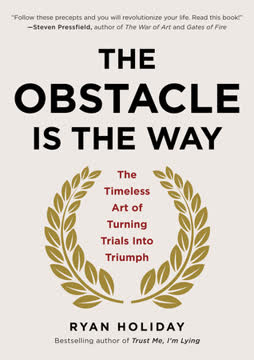मुख्य निष्कर्ष
1. स्थिरता और आंतरिक शांति के लिए स्टोइक सिद्धांतों को अपनाएं
"सर्वश्रेष्ठ प्रतिशोध यह है कि आप अपने दुश्मन की तरह न बनें।"
स्टोइकवाद एक व्यावहारिक दर्शन। स्टोइकवाद एक संतोषजनक जीवन जीने के लिए एक व्यावहारिक दृष्टिकोण प्रदान करता है, जो सद्गुण, तर्क और आत्म-नियंत्रण पर केंद्रित है। इसके मुख्य सिद्धांतों में शामिल हैं:
- जो हमारे नियंत्रण से बाहर है, उसे स्वीकार करना
- तर्कशीलता के माध्यम से आंतरिक शांति को विकसित करना
- आत्म-अनुशासन और संतुलन का अभ्यास करना
- विपरीत परिस्थितियों में स्थिरता विकसित करना
इन सिद्धांतों को अपनाकर, व्यक्ति मानसिक दृढ़ता और भावनात्मक स्थिरता विकसित कर सकते हैं, जिससे वे जीवन की चुनौतियों का सामना गरिमा और बुद्धिमानी के साथ कर सकें।
2. उस पर ध्यान केंद्रित करें जो आप नियंत्रित कर सकते हैं और जो आप नहीं कर सकते, उसे स्वीकार करें
"आपके मन पर आपका अधिकार है - बाहरी घटनाओं पर नहीं। इसे समझें, और आप शक्ति पाएंगे।"
नियंत्रण का द्वंद्व। स्टोइकवाद इस बात पर जोर देता है कि हमें यह समझना चाहिए कि क्या हमारे नियंत्रण में है और क्या नहीं। इस अवधारणा को "नियंत्रण का द्वंद्व" कहा जाता है, जो मानसिक शांति और व्यक्तिगत प्रभावशीलता बनाए रखने के लिए महत्वपूर्ण है।
- हमारे नियंत्रण में: हमारे विचार, निर्णय, दृष्टिकोण और क्रियाएँ
- हमारे नियंत्रण से बाहर: बाहरी घटनाएँ, दूसरों की राय, और परिणाम
हमारी ऊर्जा को उस पर केंद्रित करके जो हम प्रभावित कर सकते हैं और जो हम नहीं कर सकते, उसे स्वीकार करके, हम अनावश्यक तनाव और चिंता को कम कर सकते हैं, जिससे हम जीवन की चुनौतियों का अधिक प्रभावी ढंग से सामना कर सकें।
3. आत्म-अनुशासन का अभ्यास करें और सद्गुणी आदतें विकसित करें
"कोई भी व्यक्ति स्वतंत्र नहीं है जो स्वयं का स्वामी नहीं है।"
स्वयं पर नियंत्रण विकसित करना। आत्म-अनुशासन स्टोइक दर्शन का एक मुख्य आधार है, जो सद्गुणी आदतें विकसित करने और व्यक्तिगत विकास प्राप्त करने के लिए आवश्यक है। आत्म-अनुशासन के प्रमुख पहलुओं में शामिल हैं:
- संतोष को टालना
- सभी चीजों में संतुलन का अभ्यास करना
- इच्छाशक्ति और मानसिक दृढ़ता को विकसित करना
- लगातार अपने कार्यों को मूल्यों के साथ संरेखित करना
आत्म-नियंत्रण का अभ्यास करके और सकारात्मक आदतें विकसित करके, व्यक्ति अपने चरित्र और स्थिरता को बना सकते हैं, जिससे वे बाधाओं को पार कर सकते हैं और अपने लक्ष्यों को प्राप्त कर सकते हैं।
4. दैनिक जीवन में जागरूकता और ध्यान का अभ्यास करें
"आपके मन पर आपका अधिकार है - बाहरी घटनाओं पर नहीं। इसे समझें, और आप शक्ति पाएंगे।"
वर्तमान क्षण में जीना। स्टोइकवाद इस बात पर जोर देता है कि हमें अपने दैनिक जीवन में पूरी तरह से उपस्थित और जागरूक रहना चाहिए। यह ध्यान का अभ्यास शामिल है:
- बिना निर्णय के अपने विचारों और भावनाओं का अवलोकन करना
- वर्तमान क्षण पर ध्यान केंद्रित करना, न कि अतीत में रहने या भविष्य की चिंता करने में
- नियमित रूप से अपने कार्यों और प्रेरणाओं पर विचार करना
जागरूकता को विकसित करके, हम बाहरी घटनाओं पर अपनी प्रतिक्रियाओं को बेहतर तरीके से नियंत्रित कर सकते हैं और अपने मूल्यों के साथ संरेखित अधिक जानबूझकर विकल्प बना सकते हैं।
5. विपरीत परिस्थितियों को विकास के अवसर के रूप में अपनाएं
"कार्य में बाधा कार्य को आगे बढ़ाती है। जो रास्ते में खड़ा है, वही रास्ता बन जाता है।"
बाधाओं को अवसरों में बदलना। स्टोइकवाद सिखाता है कि विपरीत परिस्थितियाँ और चुनौतियाँ स्वाभाविक रूप से नकारात्मक नहीं होतीं, बल्कि इन्हें विकास और आत्म-सुधार के अवसरों के रूप में देखा जा सकता है। इस दृष्टिकोण में शामिल है:
- कठिनाइयों को स्थिरता और चरित्र विकसित करने के अवसरों के रूप में पुनः फ्रेम करना
- हर असफलता में पाठ और व्यक्तिगत विकास की खोज करना
- एक विकास मानसिकता को अपनाना जो चुनौतियों को अस्थायी और पार करने योग्य मानती है
इस मानसिकता को अपनाकर, व्यक्ति बाधाओं को व्यक्तिगत विकास और सफलता के लिए कदमों में बदल सकते हैं।
6. प्रकृति और तर्क के अनुसार जिएं
"जो अपने साथ सामंजस्य में जीता है, वह ब्रह्मांड के साथ सामंजस्य में जीता है।"
प्राकृतिक क्रम के साथ संरेखण। स्टोइकवाद प्रकृति और तर्क के अनुसार जीने पर जोर देता है, जिसमें शामिल है:
- ब्रह्मांड के प्राकृतिक क्रम को समझना और स्वीकार करना
- अपने कार्यों और निर्णयों को मार्गदर्शित करने के लिए तर्क का उपयोग करना
- ज्ञान, न्याय, साहस, और आत्म-नियंत्रण जैसे सद्गुणों को विकसित करना
प्रकृति और तर्क के साथ संरेखित होकर, हम अपने जीवन में अधिक सामंजस्य प्राप्त कर सकते हैं और उद्देश्य और संतोष की भावना विकसित कर सकते हैं।
7. मृत्यु के लिए तैयार रहें ताकि आप अधिक पूर्णता से जी सकें
"आप अभी जीवन छोड़ सकते हैं। इसे तय करें कि आप क्या करते हैं, कहते हैं और सोचते हैं।"
मेमेंटो मोरी। स्टोइक अभ्यास, जो मृत्यु पर विचार करने के लिए जाना जाता है, "मेमेंटो मोरी," एक शक्तिशाली अनुस्मारक के रूप में कार्य करता है कि हमें पूरी तरह से और जानबूझकर जीना चाहिए। इस अभ्यास में शामिल है:
- जीवन की सीमित प्रकृति पर नियमित रूप से विचार करना
- मृत्यु के ज्ञान का उपयोग करके वास्तव में महत्वपूर्ण चीजों को प्राथमिकता देना
- वर्तमान क्षण के लिए आभार विकसित करना
हमारी मृत्यु को अपनाकर, हम जीवन की चुनौतियों पर एक दृष्टिकोण प्राप्त कर सकते हैं और यह तय कर सकते हैं कि हम अपना समय और ऊर्जा कैसे व्यतीत करें।
अंतिम अपडेट:
FAQ
What's The Daily Stoic about?
- Daily Meditations: The Daily Stoic offers 366 meditations on wisdom, perseverance, and the art of living, inspired by Stoic philosophers like Seneca, Epictetus, and Marcus Aurelius.
- Practical Philosophy: It aims to make Stoicism accessible and applicable to modern life, focusing on self-mastery and resilience.
- Structured Approach: The book is organized into three disciplines: Perception, Action, and Will, with each month dedicated to a specific theme.
Why should I read The Daily Stoic?
- Timeless Wisdom: Stoic teachings provide valuable insights for handling life's challenges, making them relevant for today's fast-paced world.
- Daily Reflection: The format encourages daily reflection, helping readers gradually integrate Stoic principles into their lives.
- Diverse Appeal: It appeals to a wide range of readers, from business leaders to athletes, enhancing performance and well-being across various fields.
What are the key takeaways of The Daily Stoic?
- Control and Choice: Focus on distinguishing between what is within your control and what is not, as emphasized by Epictetus.
- Virtue as Happiness: True happiness comes from virtue, including self-control, courage, justice, and wisdom, rather than external possessions.
- Resilience in Adversity: View obstacles as opportunities for growth, following Marcus Aurelius's idea that “the obstacle on the path becomes the way.”
What are the best quotes from The Daily Stoic and what do they mean?
- “You control your mind”: Highlights the Stoic belief that our thoughts shape our reality, urging focus on internal responses.
- “The obstacle is the way”: Suggests that challenges should be embraced as they lead to personal growth.
- “What is in keeping with your character?”: Encourages aligning actions and decisions with personal values and principles.
How does The Daily Stoic define Stoicism?
- Practical Philosophy: Stoicism is a way of life emphasizing rationality, self-control, and virtue as paths to true happiness.
- Focus on Perception: It teaches that our perceptions, not events themselves, cause distress, highlighting thought management.
- Three Disciplines: The philosophy is structured around Perception, Action, and Will, focusing on how we see, respond, and endure.
What is the Stoic concept of prohairesis?
- Reasoned Choice: Prohairesis refers to our ability to make reasoned choices, central to Stoic philosophy.
- Control and Responsibility: It emphasizes focusing on judgments and actions within our control, not external circumstances.
- Foundation of Virtue: By exercising prohairesis, we align actions with virtue, leading to a fulfilling life.
How does The Daily Stoic address the idea of amor fati?
- Love of Fate: Amor fati is the practice of embracing everything that happens as necessary and beneficial.
- Transforming Perspective: By loving our fate, we find peace and contentment, regardless of external conditions.
- Empowerment Through Acceptance: This mindset empowers control over reactions and attitudes, fostering resilience.
What is the significance of daily meditations in The Daily Stoic?
- Daily Practice: Meditations encourage reflection, helping readers apply Stoic principles daily.
- Building Habits: Cultivates resilience and mindfulness, reinforcing teachings through consistent engagement.
- Personal Growth: Each meditation provokes thought and inspires action, guiding readers toward self-understanding.
How can I apply the teachings of The Daily Stoic in my life?
- Daily Reflection: Set aside time daily to read and reflect on meditations, fostering introspection.
- Mindfulness Practice: Cultivate mindfulness, focusing on reactions and maintaining a calm mindset.
- Embrace Challenges: View obstacles as growth opportunities, applying the idea that “the obstacle on the path becomes the way.”
How does The Daily Stoic suggest handling adversity?
- View Challenges as Opportunities: Adversity is natural and should be seen as a chance for growth and learning.
- Maintain Composure: Encourages a calm and rational mindset in difficulties, aiding decision-making and resilience.
- Practice Acceptance: Accepting the unchangeable helps focus on responses rather than challenges.
What role does gratitude play in The Daily Stoic?
- Cultivating Appreciation: Emphasizes gratitude as a practice enhancing well-being and perspective.
- Counteracting Negativity: Gratitude counters entitlement and dissatisfaction, promoting positivity.
- Daily Reflection: Incorporating gratitude into reflections leads to a fulfilling life, focusing on abundance.
What is the significance of eudaimonia in The Daily Stoic?
- Flourishing and Well-Being: Eudaimonia is the ultimate goal, emphasizing living in accordance with virtue.
- Inner Peace: Achieving it involves cultivating peace and contentment through virtuous living.
- Long-Term Perspective: True happiness comes from focusing on character and virtue, not fleeting pleasures.
समीक्षाएं
द डेली स्टोइक को मिश्रित समीक्षाएँ मिलती हैं, जिसमें कई लोग इसकी स्टोइक दर्शन और दैनिक ध्यान के सुलभ दृष्टिकोण की प्रशंसा करते हैं। पाठक इस पुस्तक की व्यावहारिक बुद्धिमत्ता और जीवन को बदलने की क्षमता की सराहना करते हैं। कुछ इसे दोहरावदार या सतही मानते हैं, और हॉलिडे की व्याख्याओं की आलोचना करते हैं। कई पाठक दैनिक पठन और प्राचीन स्टोइक विचारकों के उद्धरणों के प्रारूप का आनंद लेते हैं। आलोचकों का तर्क है कि यह पुस्तक जटिल विचारों को अत्यधिक सरल बना देती है और गहराई की कमी है। विभाजित रायों के बावजूद, कई पाठक इस पुस्तक के दैनिक चिंतन में मूल्य पाते हैं और इसे आधुनिक दर्शकों के लिए स्टोइक अवधारणाओं को प्रस्तुत करने की क्षमता के लिए सराहते हैं।





















